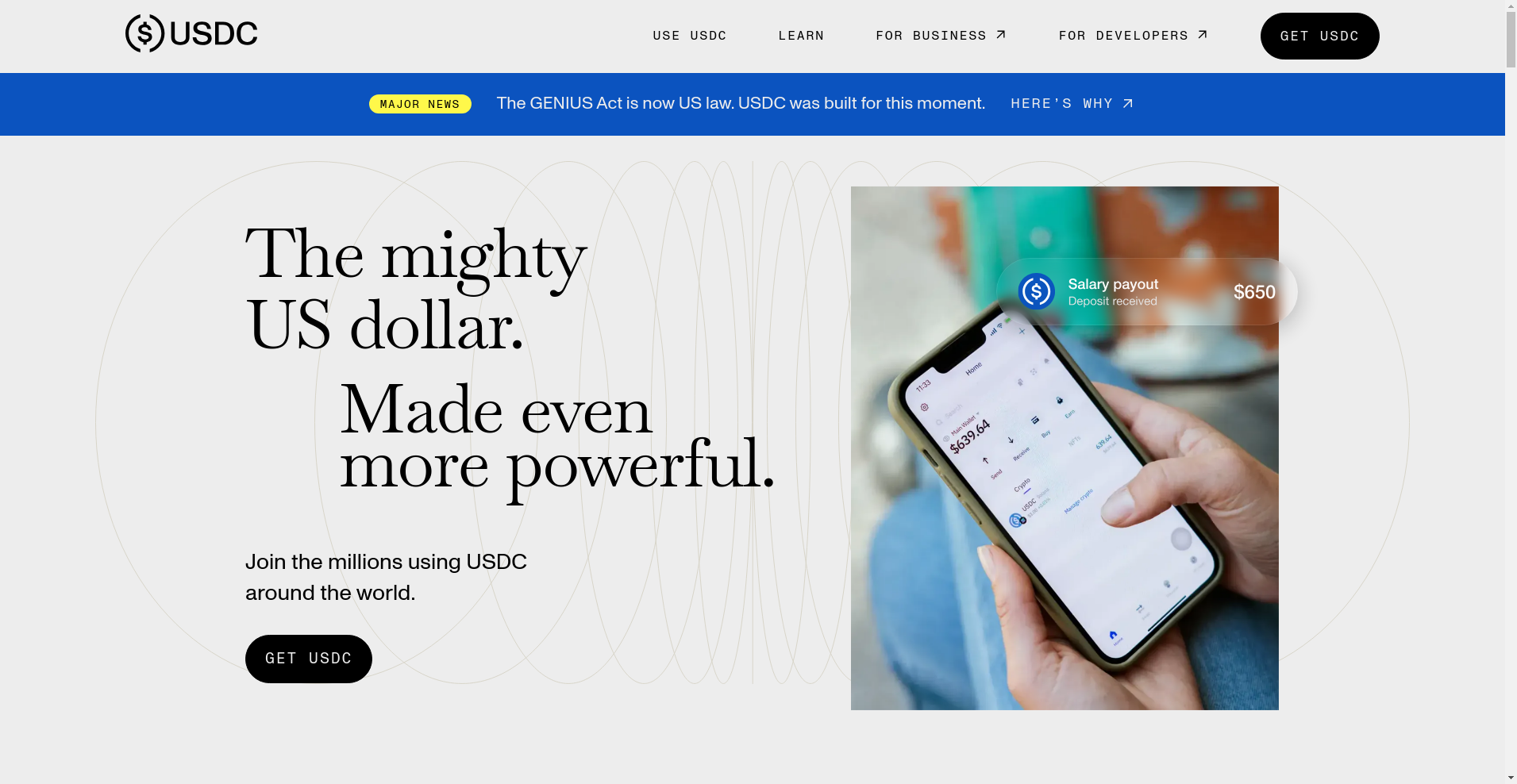USD Coin ($USDC) Review: A Data-Driven Legitimacy and Risk Assessment

What Is USD Coin: An Introduction
USD Coin, commonly known by its ticker $USDC, is a stablecoin issued by Circle, designed to maintain a 1:1 peg to the US dollar. Launched with the aim of bridging traditional finance and blockchain technology, USDC seeks to provide a reliable, regulated Digital Dollar that facilitates fast, low-cost transactions across the globe.
This project emphasizes regulatory compliance, transparency, and security. It functions as a digital representation of USD, backed by cash and cash equivalents held in top-tier financial institutions and verified through monthly audits. As part of the broader stablecoin ecosystem, USDC plays a critical role in DeFi, trading, remittances, and mainstream digital payments.
This review offers an impartial analysis of USDC's strengths and vulnerabilities based on available data, focusing on its legitimacy, security, economic model, and broader ecosystem potential. Understanding stablecoin risk mitigation strategies is crucial for any investor in this space.
The Team and Vision Behind USD Coin
Circle, the issuer of USDC, is a well-known and publicly registered financial technology company. It has a transparent operational history, and its leadership team comprises industry veterans with prior experience in banking, payments, and blockchain development. The company operates under several regulatory licenses, especially in the US and Europe, indicating a commitment to legal compliance and institutional credibility. Circle's focus on regulatory compliance is a key aspect of its strategy.
Circle’s strategic vision centers around creating a regulated, trusted digital dollar infrastructure that can serve multiple use cases from remittances to institutional finance. Their roadmap has included broad adoption, integrations with major exchanges, and expanding access to different jurisdictions.
- Established partnerships with leading banks and financial institutions, such as The Bank of New York Mellon and BlackRock.
- Development of compliance frameworks aligned with US and European regulations.
- Continued integration with key blockchain networks, digital wallets, and DeFi platforms.
Based on current progress, the team appears capable of fulfilling their near-term milestones. However, larger technological and regulatory hurdles remain, which could influence their long-term delivery ability.
USD Coin Security Audit Results
Analyzing the security and trustworthiness of USDC relies heavily on the provided audit report from Cer.live. According to this source, the audit coverage is marked as 'LIVE,' with the project categorized firmly as a stablecoin. The audit score is approximately 6.35 out of 10, indicating moderate transparency but not without room for improvement.
It is important to note that only a single audit source was available, limiting a comprehensive security assessment. Nonetheless, the key findings reveal the following:
- Reserves Adequately Backed: The USDC in circulation (~62 billion) is backed by cash and cash equivalents, with monthly attestations performed by a Big Four accounting firm, InsurAce providing insurance coverage. Understanding the details of USDC's reserve backing mechanisms is vital for assessing its stability.
- Concentration Risks: Reserves are held with premier banking partners, including The Bank of New York Mellon and managed by BlackRock, reducing centralization fears.
- Vulnerabilities: The audit highlights incidents of potential vulnerabilities but does not specify major security breaches or exploits.
- Transparency: Regular reserve attestations bolster trust, though some technical vulnerabilities or governance concerns might exist, as suggested by the moderate rating.
Overall, the security assessment indicates USDC benefits from regulated reserve management and institutional oversight, which enhances its perceived trustworthiness. However, reliance on a single audit report introduces a degree of uncertainty, and continued independent audits are advisable for sustained security confidence.
A Breakdown of USD Coin Tokenomics
Understanding USDC’s economic model involves examining its supply mechanics, token utility, and distribution policies. As a stablecoin, USDC's primary purpose is to provide a 1:1 USD peg, ensuring price stability and liquidity for various applications.
The key tokenomics aspects are:
- Total Supply: Approximately 62 billion USDC tokens are in circulation, with a circulating supply that fluctuates based on user demand and reserve minting/burning activities.
- Token Utility: USDC is used mainly for transferring value quickly across platforms, hedging against volatility, and participating in DeFi protocols. Its main appeal is reliability rather than speculative gains.
- Distribution & Allocation: USDC is minted and redeemed on demand through Circle’s platform, with reserves held in cash and cash equivalents. Specific allocation to team, advisors, or VCs is not publicly disclosed, consistent with its stablecoin nature.
- Vesting & Administrative Controls: Since USDC is not a typical ERC-20 token with inflationary or deflationary features, its supply adjustments are governed by minting and burning processes tied directly to reserve backing.
- Potential Risks: The physical backing model introduces risks related to reserve management, including potential mismatches and regulatory changes affecting redemption rights.
From an economic sustainability perspective, USDC’s model relies on transparent reserve backing and continuous regulation. Its pegged nature reduces volatility but makes it vulnerable to reserve mismanagement or regulatory crackdowns that could impair redemption guarantees.
Assessing USD Coin's Development and Ecosystem Activity
USDC demonstrates consistent development activity, driven by partnerships with leading blockchain platforms like Ethereum, Solana, and others. Its ecosystem expands through integration with DeFi protocols, exchanges, and digital wallets, indicating ongoing adoption and utility growth.
In recent reports, growth in circulation volume (~30% yearly increase) suggests healthy demand across diverse sectors, including remittances, trading, and institutional finance. Despite some marketing announcements, the core development efforts focus on improving compliance, security, and cross-chain interoperability.
Notably, USDC’s presence on major exchanges and its role in facilitating instant transactions underline its integration into everyday financial operations. Nevertheless, some criticism revolves around reliance on centralized custodians and the potential impact of regulatory shifts on future development.
The Fine Print: Analyzing USD Coin's Legal Framework
From the available documentation, USDC's terms emphasize rigorous compliance with applicable regulations, including licenses in multiple jurisdictions. The project explicitly states that it is designed to adhere to laws such as the GENIUS Act passed into US law.
Some noteworthy clauses include:
- Reserves are held and attested monthly by independent firms, ensuring transparency but not eliminating the risk of reserve mismatch or misreporting.
- Redemption rights are protected under regulations, but changes in legal frameworks could affect the operational environment.
- No explicit restrictions on use or transfer are noted, aligning with typical stablecoin policies.
Overall, the legal framework appears robust, but potential investors should remain aware of evolving regulations that could impact reserve backing or operational controls.
Final Analysis: The Investment Case for USD Coin
In sum, USD Coin stands out as one of the most legitimate and widely adopted stablecoins. Its backing by regulated institutions, frequent transparency attestations, and broad ecosystem integrations balance well against some limitations, such as audit scope and reliance on centralized reserves.
From a risk perspective, the primary concerns involve regulatory shifts, reserve management integrity, and technology reliance. Conversely, its strengths include regulatory compliance, institutional backing, and wide adoption, making it a resilient component of the digital asset infrastructure.
Potential users and investors should consider these factors in relation to their risk appetite and use case requirements. The project’s focus on stability, transparency, and compliance render it a relatively secure option within the volatile and evolving blockchain landscape.
Pros / Strengths
- Widely recognized and trusted regulatory backing from Circle.
- High transparency with monthly attestations by reputable auditors.
- Broad ecosystem integration across exchanges, wallets, and DeFi platforms.
- Designed for global accessibility with high liquidity.
- Built-in security protocols with institutional custodianship.
Cons / Risks
- Audit coverage limited to a single source, restricting comprehensive security assessment.
- Dependence on centralized reserves, which could face regulatory or operational risks.
- Potential regulatory changes in key markets could impact operations or redemption rights.
- Opaque disclosure on specific reserve holdings and distribution policies.
- Susceptibility to systemic risks inherent to the custodial manner of reserve management.
Based on the current data, USD Coin (USDC) maintains a strong legitimacy profile supported by regulatory compliance and institutional oversight. However, investors must monitor ongoing audits, regulatory shifts, and reserve management practices to gauge its future resilience.

Olivia Lewis
Sociotechnical Systems Analyst
I analyze the intersection of social networks and blockchain systems. I use data to expose how scammers manipulate communities with bots, FUD, and engineered hype.
Similar Projects
-
Avalon Games
Avalon Games Review: Crypto Scam Checker and Project Scam Review
-
Bullie
Bullie Review: Scam or Legit Crypto? Cryptocurrency Scam Check
-
Coffy DeFi
Coffy DeFi ($COFFI) Review: Risks and Security Insights
-
Empowa
Comprehensive Empowa Review: Is This Crypto Project a Scam or Legit? | Crypto Scam Checker & Review
-
BANG
BANG Review: Scam Check & Legitimacy Analysis of This Crypto Meme Coin